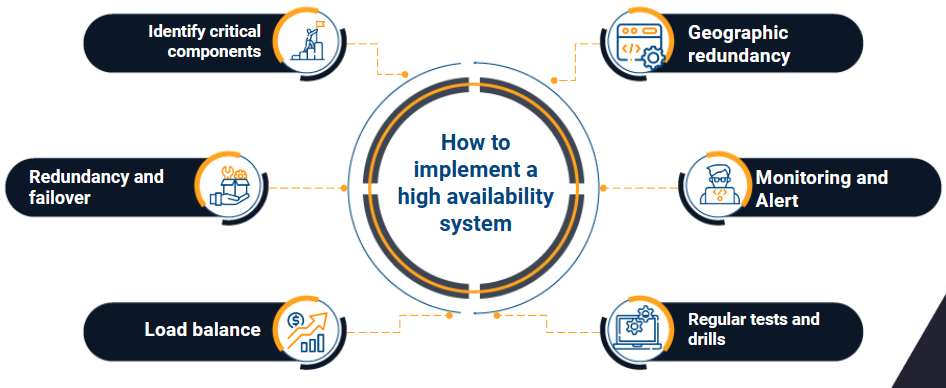Within cybersecurity, a technological solution that focuses on keeping software products such as applications and web pages protected, there are several services focused on a single aspect of the technical project, among them are high availability systems.
To define what this term consists of, perhaps completely unknown to a person outside the technological world, we turn to what Red Hat says “High availability combines two concepts to determine if a system meets its level of operational performance: the first must to do with the practically permanent accessibility or availability of a service or server without downtime; and the second refers to its performance according to reasonable expectations and for a stated period.”
How is a high availability system implemented?
Implementing high availability systems involves careful planning, architectural design, and ongoing maintenance.
Here's a step-by-step guide to help you get started:
- Identify critical components: Start by identifying the critical components of your infrastructure. These are the parts that, if they fail, would cause the most disruption. This could include databases, web servers, load balancers, and storage systems.
- Redundancy and failover: Introduce redundancy for these critical components. For example, you may have multiple database servers or load balancers. Set up automatic failover mechanisms that can detect when a component fails and seamlessly switch to a backup.
- Load Balancing: Use load balancers to distribute incoming traffic across multiple servers or instances. This not only ensures better performance but also provides redundancy. If one server fails, the load balancer can route traffic to other healthy servers.

- Geographic redundancy: Consider geographic redundancy if your applications serve a global audience. Host your systems in multiple data centers or regions. Cloud providers often offer this feature, which can ensure continued service availability even if a region experiences issues.
- Monitoring and Alerting: Implement robust monitoring and alert systems. These tools can continually monitor your infrastructure and notify you when problems arise. Proactive monitoring allows you to address potential issues before they cause downtime.
- Regular testing and drills: Periodically test your high availability configuration. Conduct drills and simulate failure scenarios to ensure failover mechanisms work as expected. This helps identify and rectify any weaknesses in your setup.
- Documentation and training: Document your high availability strategy and ensure your team is well trained in its implementation and maintenance. Having trained staff and clear documentation is essential for a smooth recovery process.
- Third-party services and dependencies: Don't forget about third-party services or dependencies that your systems depend on. Make sure these services have their own high availability strategies and that they align with your recovery goals.
By investing in redundancy, failover mechanisms, and proactive monitoring, you can ensure that your applications and services remain operational even in the face of disruptions.
Benefits of a high availability system
Specially designed to minimize downtime, a high availability system is of great benefit to critical applications or infrastructure components. Implementing a system of this type can benefit:
- Reduced Downtime: The primary benefit of an HA system is a significant reduction in downtime. This ensures that your critical systems and services are available to users or customers 24 hours a day, improving overall service reliability.
- Improved Reliability: HA systems are built with redundancy and failover mechanisms, making them more reliable. If one component or server fails, another takes over, ensuring continuous service without interruptions.
- Improved user experience: High availability systems result in a better user experience. Users can access services and data without interruption, leading to greater satisfaction and trust in your organization.
- Business Continuity: HA systems are crucial for business continuity. They help you maintain operations during unexpected events, such as hardware failures, network problems, or even natural disasters.
- Data integrity: Data is often a critical asset for organizations. HA systems typically include data backup and replication mechanisms to ensure data integrity. This means that even in the event of a failure, data loss is minimized.
- Scalability: Many HA systems are designed with scalability in mind. As your organization grows, it's easier to scale the system horizontally or vertically to meet increased demand without significant downtime.
High availability is not just a business strategy; It is an essential component of providing a reliable and consistent experience to your users.
We recommend you on video


